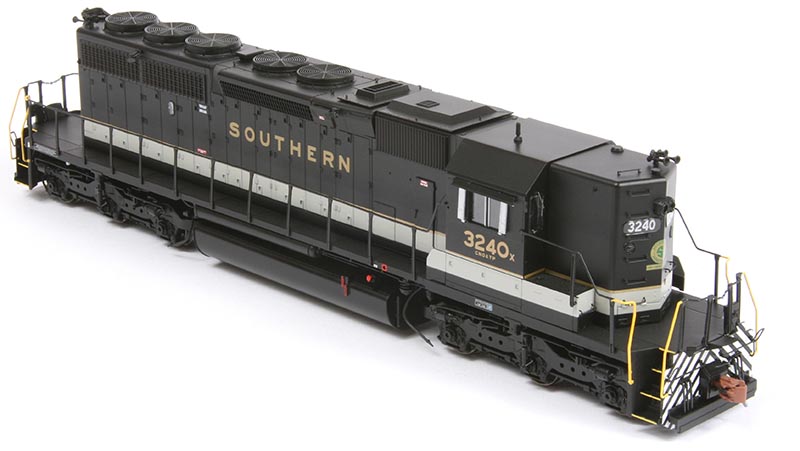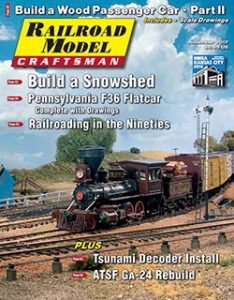 Review by David Otte/photos by the author
Review by David Otte/photos by the author
Although relatively new to the scene, ScaleTrains has already left its mark on the hobby industry with the manufacturer’s highly acclaimed Museum Quality-series HO-scale Union Pacific Super Turbine release of 2016. Now the Tennessee- based company is tackling perhaps an even greater undertaking — a 1:87 Electro-Motive Division (EMD) SD40-2 diesel locomotive model. While not the first rendering of this venerable locomotive in HO, this attempt promises to be the last word on the prototype, eventually encompassing all the major and minor production phase changes of this popular diesel, as well as road-specific details. While its signature Rivet Counter- series will reflect all these nuances, ScaleTrains is also offering the SD40–2 as a more basic Operator-series model for those hobbyists looking for a more affordable option.
The moment of truth is now at hand as the first round of SD40-2s has arrived, including those decorated for Burington Northern, Chessie System, CSX, Southern Railway, and Union Pacific in the Rivet Counter lineup, either Digital Command Control (DCC) ready or factory-equipped with DCC/sound. Units lettered for BNSF, CSX, Norfolk Southern, and UP are available under the Operator brand — DCC-ready only — with factory-equipped sound units arriving in early 2018. The second batch of Rivet Counter SD40–2s is already in the works for a late 2017 delivery, featuring Chicago & North Western, The Milwaukee Road, Santa Fe (snoot-nose), and Norfolk Southern (rebuilt SD40-3). Multiple road numbers are being offered for each scheme as appropriate (sorry, no undecorated units in this release) with a $79.95 suggested selling pricing at time of delivery for the Operator SD40-2, while the Rivet Counter models start at $139.95 for DCC-ready and $199.95 for DCC/sound-equipped models.
The SD40-2’s origin dates back to 1966 when EMD introduced an innovative lineup of general purpose and special duty road locomotives all designed around its new 645-series engine, AR10 alternator, and D77 traction motor. In particular, the technology packed into this series, which included the four-axle GP38 and GP40, as well as six-axle SD38, SD40, and SD45 models, established new industry standards that would further set apart EMD from its competitors. Initially, the 3,600-hp SD45 garnered the most attention, as the mid-1960s horsepower race was in full swing. However, by the end of the decade and with the discovery of the 20-cylinder 645 engine’s appetite for both fuel and extended maintenance, the 16-cylinder 3,000-hp SD40 would emerge as the locomotive of choice for the majority of railroads. As the question of horsepower no longer figured into the equation, EMD next turned its attention to fulfilling its customers’ requests for improved reliability and reduced maintenance costs.

EMD unveiled its next generation of motive power in January 1972. The new models now carried a simple “–2” behind their designations. Yet, this seemingly insignificant suffix, as bolstered by these locomotives’ very subtle changes in exterior appearances, failed to adequately describe the numerous pioneering enhancements hidden within their carbodies. For the SD40-2, this would entail some 40 design improvements to the existing SD40 model that raised the locomotive’s efficiency levels to new heights.
Outwardly, the locomotive exhibited some minor sheet metal changes to the cab and battery box, a water sight glass was installed in a right rear hood door, and the unit now rode on new hi-adhesion HTC three-motor trucks with a suspension designed to reduce weight transfer and wheel slip. These longer-wheelbase trucks required a longer frame (three feet longer than the SD40), while the rear hood length remained the same, which resulted in what railfans referred to as the “rear porch” — a primary spotting characteristic of the SD40–2. Internally, its turbocharged 645E3 variant prime mover contained upgraded pistons, piston rings, and redesigned bearings throughout; the alternator and traction motors were refined; and the cab received increased insulation, larger gauges, and an improved control stand.
On the inside, the Dash 2 lineup heralded in a new electrical control system based on transistors and printed circuit boards managed by up to 17 different solid- state modular components, which governed everything from voltage regulation and battery charging to throttle response, wheel-slip control, dynamic braking, and even sanders. Troubleshooting was simplified to the point that a test module was able to easily diagnose performance issues, which could often be corrected by simply replacing a defective circuit board or module. In this way, the Dash 2 series laid the groundwork for the advanced computerized control systems of today’s diesel locomotives.
During the mid-1970s, railroads went on a buying spree not seen by the industry since the transition years from steam to diesel. Fueled in part by a burgeoning coal industry, EMD would see sales of its SD40-2 reach the farthest corners of the North American continent as units would eventually serve in all lower 48 states, throughout almost every Canadian province, and in Mexico via 30 different original purchasers. When production finally came to an end in early 1986, EMD had produced 3,945 SD40-2s plus an additional 346 variants of the freight locomotive, including the famous SD40T-2 “tunnel motors” and the full-cowl SD40-2Fs delivered to Canadian Pacific in November 1988. To date, the SD40-2 has been one of the most successful-selling locomotives in EMD’s history with a good portion of the units still serving on Class I and regional roads yet today.
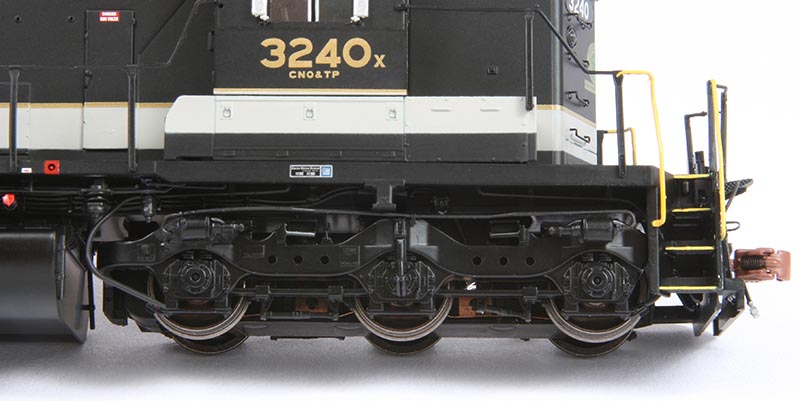
Treating this monumental American locomotive prototype with the respect it deserves, ScaleTrains’ new HO-scale rendering is an attention-grabber from the get-go. Besides the fact that its general measurements and carbody profile match the real deal to a T, the HO-scale SD40-2 is loaded with an outstanding level of detail, top to bottom — from the see-through radiator fans on the roof to the sliding side windows in the cab to the realistic chassis-mounted sanding lines leading down to the railhead. Both the plethora of add-on parts, as well as the molded-in features found on the injection- molded hoods, cab, and walkway/ end platform assemblies are crisp in appearance, as one would expect of 21st century tooling. Even the side sills incorporated into the die-cast metal frame exhibit an array of conduit and plumbing lines running along their length.
Nonetheless, the more important story here regarding this highly anticipated release is the variations ScaleTrains has had to carefully integrate into each model. For any road’s particular SD40–2, this juggling act involves mixing the appropriate production phase with the correct road-specific details and then matching these with the right era paint and lettering scheme. It’s an enormous task for this prototype, considering the number built, but the manufacturer appears to be on the ball.
To better appreciate the effort, a quick summary of the major production phases is in order. Generally, railfans feel there are three distinct divisions: Phase I units were built with side sills notched for the fuel tank, had vertically straight blower duct arrangements exhibiting two horizontal ribs, utilized the early 81-inch long short hood, and had a separate ECAFB (electrical cabinet air filtration box) located on the walkway behind the left side of the cab. Phase II SD40-2s (starting in early 1977) were differentiated by an 88-inch long short hood and an ECAFB situated flush with the cab wall all while maintaining notched side sills. Finally, Phase III units (introduced late 1981/early 1982) were denoted by straight narrow side sills and, eventually, angled blower duct housings.
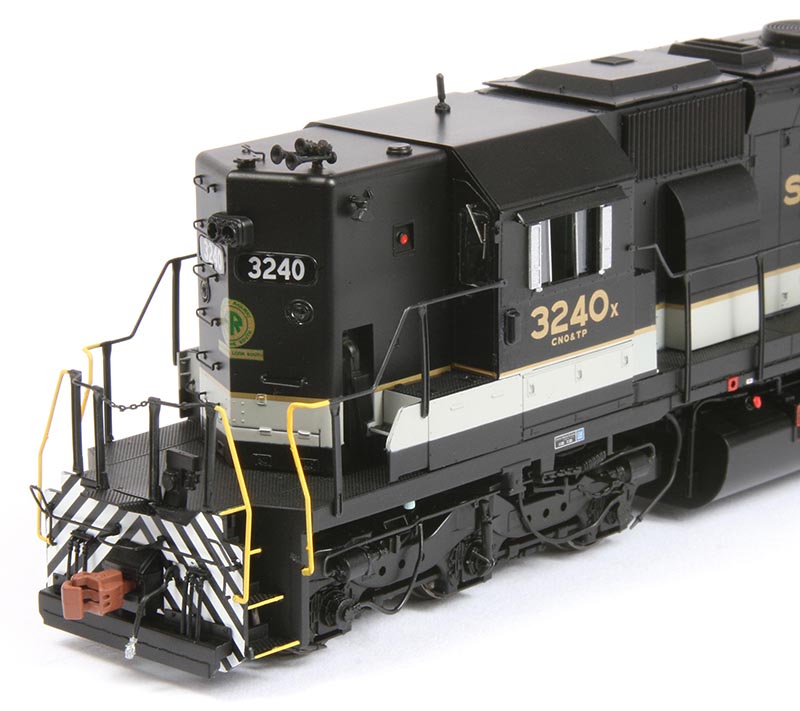
Intertwined with these major demarcations is a long list of other more minor modifications that break all these phases into multiple levels of sub-phases with some characteristics even present across the major phase demarcations. I won’t go into them all (the details can become rather confusing), but a few important stand-outs include the initial use of square, wire mesh-covered radiator intake grilles changed to the corrugated style in mid-to-late 1976. The flat-top radiator fans and raised exhaust stacks were used up until 1980 when, due to a government mandate regarding noise regulations, the new Q fans and flat-top exhaust silencers went into effect. Cabs went from riveted- to welded-constructed side panels, and either an early ratchetstyle or mid-to-late production wheeltype handbrake was employed, located on the left side of the short hood.
Throw all the possible road-specific details into this mix, like snowplows, air horn styles, radio antennas, and the like, and you can see what a model manufacturer taking on the SD40–2 project is up against. It may take some time, but Scale- Trains appears poised and dedicated to releasing examples of all the production variations. Railroad Model Craftsman’s review sample will serve as a starting point for this ongoing endeavor.
Southern Railway 3240x (the “x” being a mathematically based check code letter in Southern’s post-1971 computerized tracking system) was just one of 128 SD40–2s purchased by the road between 1972 and 1979. It was included in a group (numbers 3231–3240) designated for subsidiary Cincinnati, New Orleans & Texas Pacific (CNO&TP) and delivered in September 1973. As such, it’s considered an early production model labeled as Phase Ia2. The model correctly reflects the telltale signs of this railfan designation, displaying the square wire mesh radiator intake grilles, 81-inch-long short hood, cab side walls with 11 rivet heads visible above and below the windows (this would be increased to 13 rivets by Phase 1c production), and ratchet-style handbrake.
Furthermore, all the Southern Railway units featured high short hoods with the long hood officially oriented as the front (used bi-directionally in actual practice, though). The railroad had its SD40-2s dressed up with walkway lights, three-chime air horns positioned on both the short and long hood ends, a bell stationed out on the end of the long hood, a firecracker-style radio antenna atop the cab, and narrow sun visors over the side windows. While later batches of the road’s units were delivered with snowplows on both ends, these earlier production SD40-2s exhibited only flat pilot plates with hose catch trays at their base. In addition, their 4,000-gallon fuel tanks were equipped with unique staggered fuel gauges further denoting Southern ownership. All these road-specific attributes have been captured on ScaleTrains’ HO-scale rendering — even the lighting fixtures along the hoods above the walkways (non-functioning).
Bolstering this incredible accuracy is the HO-scale model’s well-executed decoration. Compared with both pho- tos of 3240x and an original Southern Railway painting diagram, the manufacturer has achieved virtual perfection in this category. From the color matching of the aluminum-gray striping on the overall black-painted body, to the sharp gold pinstriping, to the correctly dimensioned 12-inch-tall hood lettering and cab numbers, you couldn’t ask for a more faultless reproduction. The road’s herald located on the hood ends is particularly well done, as are the miniature safety placards arrayed on the various hood doors and along the sills, not to mention the fully readable EMD builder’s plates. The manufacturer has even replicated the diagonal striping on the walkway step along the long hood on the engineer’s side. Wow!
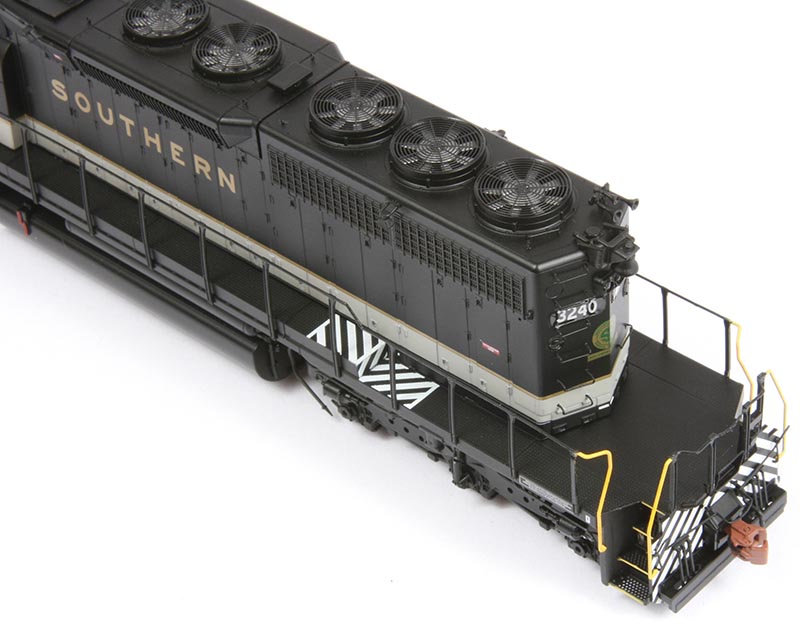
ScaleTrains’ SD40–2 also delivers some outstanding performance too. RMC’s sample, which was equipped with an ESU LokSound DCC/sound decoder, was simply a pleasure to operate on the test track. It responded immediately to Speed Step 1 on my Digitrax DT402 controller, crawling along at just a hair under 1 scale mile per hour, and maxed out with a prototypical high speed of 65 scale miles per hour. The flywheel-equipped can motor and all-wheel drive gearing were very smooth and relatively quiet straight out of the box and without any break-in period required whatsoever. The directionally controlled LED headlights appeared in a bright, realistic hue with number boards and class lights illuminated too. Drawbar pull was about average for this 18.5-ounce HO-scale locomotive reproduction but able to handle about four dozen pieces of mixed rolling stock on level track.
Wheels and couplers checked out fine, the only anomaly I encountered with Railroad Model Craftsman’s sample during my test runs involved those previously mentioned sanding lines. Being prototypically modeled, yet not actually attached to the trucks themselves, the sanding lines do have a tendency to come in contact with the sideframes, especially when the locomotive is negotiating tighter- radius curves. A somewhat annoying clicking sound could be heard when the SD40–2 rounded the test track’s 22- inch radius curves, but the sanding lines never actually interfered with the trucks’ maneuverability nor caused any derailments during my test runs. If the modeler wishes, the detail can easily be trimmed back away from the sideframes or even removed entirely.
Things really livened up, though, when the F8 key was engaged on the DCC controller and the sounds of an actual SD40– 2 brought the model to life. Depending on the version, the prime mover and incidental sounds will reflect the various nuances of the production phase or upgrades a road’s units may have received. Thus, one model release may actually sound different from another in that regard — an industry first, I believe! While I’m a big fan of LokSound decoders and found the 18 or so functions included with this SD40-2 sample met my expectations, there are a couple of highlights to note.
First, a “keep-alive” circuit is incorporated into the electronics package, so the operator never needs to concern themselves with the sounds dropping out while the locomotive traverses over lessthan- ideal track sections. Next, the class lights look awesome, as the modeler can prototypically toggle through the white, green, and red colors by simply pressing F5. Finally, as some of the more modern era SD40–2s include working ditch lights (operated by F6), the number board lighting effect has been piggybacked onto the F8 operating sounds function. Not a big deal, but, for those operators who like to run trailing units with the number boards turned off, they may find this arrangement a little disappointing. Nonetheless, the LokSound decoder does allow for function key re-mapping, and the DCC aficionado should have no trouble re-assigning the number board lighting to an open function key.
For a railfan such as myself, who grew up during the 1970s and early 1980s, the SD40–2 was the bread and butter of our train-watching sessions and subsequent modeling endeavors. As such, the impressive ScaleTrains’ rendering hits home big time for me in every analytical category and, with the continued introduction of additional tooling down the road, will be comprehensive in every detail imaginable; it is truly the absolute HO-scale SD40–2.
ScaleTrains.com, Inc.
7598 Highway 411
Benton, TN 37307 844-986-2467


